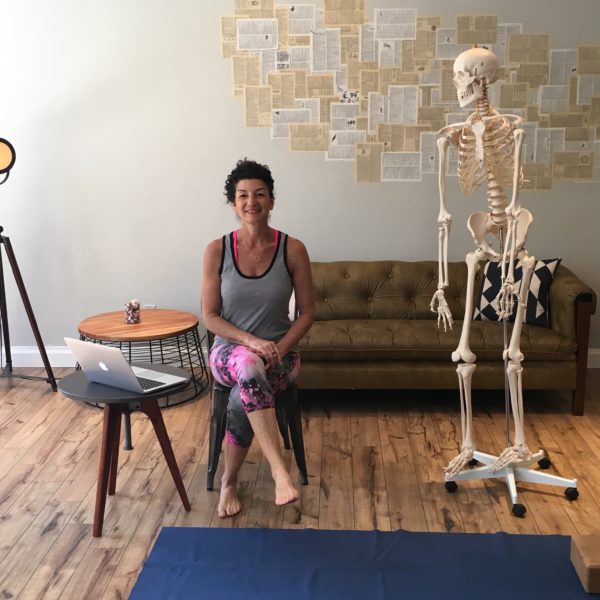 When I set out to teach  yoga, I already had a background in anatomy from my undergraduate education. I was in the Physical Therapy Program at Boston University and that started my love of anatomy. My education continued and I got my BS in Rehab Counseling after thinking that I wanted more to work with the “mind/body” not just the “body.”
When I set out to teach  yoga, I already had a background in anatomy from my undergraduate education. I was in the Physical Therapy Program at Boston University and that started my love of anatomy. My education continued and I got my BS in Rehab Counseling after thinking that I wanted more to work with the “mind/body” not just the “body.”
Fast forward many years later and I’m a yoga teacher who specializes in teaching anatomy. For me, it’s the perfect blend of “mind/body” and my focus on anatomy helps me stay connected to one of the aspects of yoga that I love.
One of the things I hear from teachers a lot is that they are overwhelmed with the topic of anatomy. They are get frustrated because they want to know the “right way” to do something and teach it to their students. This is a common concern and one that has no easy answer. On the one hand, anatomy is grounded in science so there are things that are absolutes. Things like, ” the femur is the long bone in your leg,” or “your hip joint is a ball and socket.” But once you apply the study of anatomy to individuals, things can shift a bit. Everyone is different. Plus, once you add in anatomy in the context of movement, things can get really different.
This is why it’s helpful to learn anatomy but to avoid trying to have rigid ideas about applying anatomy to students. This is also a hard thing to accept when you’re a newer teacher because of course you want answers! Also, social media makes it hard as well with articles like, “Don’t use cues like this!” or “The five mistakes people are making on the mat.” I’ll admit, I try to title my blog posts with catchy titles too but I always try to avoid something that sounds extreme. Remember, anatomy is in factual information but applied to individuals. And, in movement, the parts are impacted by many different factors, be it gravity, other forces on the body and a whole host of other things like the student’s conditioning, pre-existing injuries, and knowledge of yoga.
The other factor to keep in mind is the background of yoga. Yoga is not medicine and does not live in the medical arena. As teachers, we know of course, it has many benefits and many of these benefits help improve medical problems, like high blood pressure or lower back pain. But the practice of yoga doesn’t always focus on the anatomy, it focuses on the spiritual as well as the movement aspect of the practice. Anatomy may or may not be a part of that. I remember in my early days of practicing in the early 2000’s, we would flow in class at quite a rapid pace without a mention of anything remotely anatomical in nature when it came to cueing. Anatomy and alignment, while they can sometimes be related, are not always related, so while we may have been working towards good “alignment,” there was hardly a mention of anything anatomical in nature.
So, for some teachers, this leads them to search for information on the anatomy of yoga and this is why I’ve spent the past several years developing many different resources for teachers to help them expand their knowledge of anatomy. My goal is to inform and to help round out what they already know, as well as hone in on those specific aspects of anatomy that are helpful for teachers to know. When I teach courses on anatomy and in my anatomy manual, I start from some basic concepts and then work down into the the details. I then back out again and apply this information to several common things we do in class so that teachers have an understanding of how to apply this all to their teaching.
The common breakdown I use and what you’ll find in my anatomy manual by chapter is:
- Why Understand Anatomy
- Key Aspects of Anatomy
- Key Anatomical Terminology
- Applying Characteristics of Anatomical Position
- 12 Anatomical Reference points
- Key Bones, Joints
- The role of muscles and key muscles of the body
- Muscles and movements in poses
- Applying anatomy to teaching
- Red flags to look for
- Answering questions about injury
- Providing modifications
- Anatomical Sequences
In the manual, there are additional bonus sections as well.
If you would like to purchase the manual for $65, see this link: The Bare Bones Yoga Guide to Anatomy .
This manual will partner with my next online course and if you have the manual, you’ll get the course at a discount. There will be much more to follow on that in a few weeks. Also, my next book, “Structure and Spirit: Moving Smarter both on and off the Mat” will be out in the next few weeks too and will cover many different aspects of anatomy. Lots of content in different formats for my readers!
Keep in mind as you read it, these are guidelines that should be applied to individuals in such as way as to honor their uniqueness. Our goal as teachers is not to approach students with a rigid view of “this way is right” and “this way is wrong” but more to coach and answer questions as they come up.
If you have any questions about the manual, please let me know.
Thanks for reading!
